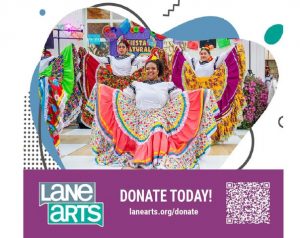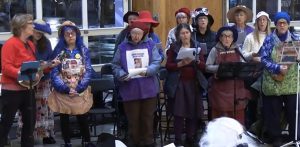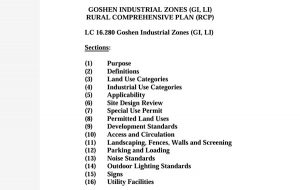State rejects Eugene middle housing code, again
11 min read
Uncertainty and risk continue for developers
by John Quetzalcoatl Murray
The Land Use Board of Appeals said Eugene’s second try at an HB 2001 middle housing ordinance still fails to comply with state Planning Goal 11.
LUBA remanded Eugene’s middle housing code, sending it back to the city for more rework.
In its ‘Final Opinion and Order’ July 10, LUBA cited a 2023 challenge to Eugene’s first middle housing ordinance from Ted Coopman, Gary Nance, and Paul Conte. Goal 11 requires a Public Facility Services Plan, or PFSP, for city water, sewer, and transportation facilities. Land uses allowed by the city, such as middle housing, should not exceed the carrying capacity of those facilities. The Oregon Court of Appeals suggested three ways the city could meet Goal 11. But the city’s second middle housing ordinance, in March 2024, did not adopt any of those approaches.
[00:00:54] Charles W. Woodward (representing Paul Conte during oral arguments June 18): My name is Charles W. Woodward IV, counsel for petitioner in this matter. We’re back again on the city of Eugene middle housing amendments, following the remand from the Court of Appeals. And unfortunately, despite the guidelines provided in Coopman, the city still has not demonstrated compliance with Goal 11.
[00:01:14] And it’s important to note sort of off the front, in context, the city has made no substantive changes to the code amendments in this remand ordinance. They only added some new findings, and repeated some—a significant portion of the old findings that were insufficient as well.
[00:01:28] It’s undisputed that the city has not adopted a new PFSP (Public Facilities Service Plan)… and it’s also undisputed the city has not undertaken an analysis of the impacts from the amendments. They just did some new findings.
[00:01:40] And again the Court of Appeals in Coopman did specifically recognize that it’s sort of expected that they’ll engage in some version of required planning or analysis for public facilities and services. And so there was no analysis or study that’s been done, and there goes two of the three ways that the Court of Appeals stated that the city could conform with the middle housing amendments.
[00:02:00] And that leaves just the ‘adopt the model code’ or the Eugene code having provisions sufficiently similar to the model code to limit middle housing, and that is sort of the gist of what’s left in the city’s findings and from their response brief as well.
[00:02:15] It’s also telling that petitioner specifically laid out some of the code provisions cited in the findings and actually detailed the specific language and how it differed from the specific language in the model code with respect to sufficient capacity… and again the city had a chance to rebut any and all of those specific code provisions in the response brief, and they did not address a single one.
[00:02:40] H.M. Zamudio (LUBA): I have a question about the adequacy of the facilities. So is your contention that that requirement derives from Goal 11 and if so, how and where?
[00:02:55] Charles W. Woodward (representing Paul Conte): The adequacy from Goal 11, this goes all the way back into the decision from Coopman where the Court of Appeals specifically said they need to make sure that it’s enough to support it. Quoting directly: ‘It has to consider the impacts of the amendments on the provision of public facilities and services.’ So adequacy, you know, therein lies the issue, is that they haven’t even analyzed any amount of impact. They specifically cite, the City Council admits, they do not know what the impacts of the amendments will be.
[00:03:23] H.M. Zamudio (LUBA): Okay, so just to clarify, your argument is that Goal 11 itself requires the city to establish adequacy of the facility contemporaneously with adopting the middle housing ordinance.
[00:03:36] Charles W. Woodward (representing Paul Conte): My standpoint is that that is exactly what the Court of Appeals has told us in Coopman. And I think a good example with respect to the specific provisions would be to look at the city’s code with regard to stormwater/sewer, which we did point out in the petition specifically does address sufficient capacity and compare that with all of the other Goal 11 facilities code provisions that do not address sufficient capacity.
[00:03:58] H.M. Zamudio (LUBA): What’s your reply to the city’s response that the existing code requires connection and I think implicitly that the development will not be approved if that connection is not possible?
[00:04:10] Charles W. Woodward (representing Paul Conte): Well, you’re talking about the private connection to the infrastructure, not an evaluation of the public infrastructure itself, which is what Goal 11 and what Coopman is all about.
[00:04:20] H.M. Zamudio (LUBA): So your position is that the city would approve an application without any assessment of the adequacy of the public facility?
[00:04:28] Charles W. Woodward (representing Paul Conte): My position is that the city has not put forward any evidence or cited to any code provision that would counter that particular statement.
[00:04:40] Lauren Sommers (Eugene): Lauren Sommers, representing the city of Eugene. The court articulated three ways in which the city could show compliance with Goal 11. First, update the public facilities plan either prior to or concurrently with adoption of the ordinance; second, adopt provisions similar to those in the model code that limit middle housing on lots that lack sufficient infrastructure; or number three, undertake an analysis to predict the impacts of the ordinance on Goal 11 facilities.
[00:05:13] So on remand the City Council considered the direction from the Court of Appeals and adopted a remand ordinance that (as Mr. Woodward said) is substantively identical to the 2022 ordinance but does include a more robust set of findings of compliance with Goal 11, including findings that the facilities already listed in the city’s adopted and acknowledged Public Facilities and Services Plan are sufficient to serve the middle housing development that’s allowed by the ordinance;
[00:05:50] Two, that the Eugene Code already includes provisions that limit development, all developments, but including development of middle housing, on lots that lack sufficient infrastructure;
[00:06:01] And three, that city staff did in fact consider the impacts of the development allowed by the remanded ordinance and determine that the city infrastructure has excess capacity to accept additional development and to serve additional development. But in the specific case where there is not enough capacity, that the necessary infrastructure would be required to be constructed prior to any approval of the proposed development, or the development would not be approved.
[00:06:31] H.M. Zamudio (LUBA): So, I think petitioner’s argument is that the city needs to identify either that the public facilities are sufficient to serve the maximum density allowed under the middle housing ordinance, or, there needs to be evidence of what the city anticipates the density resulting from the middle housing ordinance will be, I think, over what time frame, and whether the facilities are either adequate for that or will become adequate as the density grows.
[00:07:04] Do you agree with petitioner’s argument about what Goal 11 requires?
[00:07:09] Lauren Sommers (Eugene): No. I do not believe that Goal 11 requires in every case where there is a legislative land use decision that allows for, but does not require, additional density, that Goal 11 would require the city to plan for infrastructure to support the maximum density that potentially could be developed under the new ordinance. And that is certainly something that petitioner’s argument seems to assume, that the remand ordinance will result in significant increases in residential density throughout the city, and we—
[00:07:44] H.M. Zamudio (LUBA): But… from this record we don’t know what the city believes the density that will result from the middle housing ordinance will become, over what time frame, right? We don’t have any way of knowing that. The city’s position is, ‘Well, we also don’t have any way of knowing,’ right? When that plan was adopted, the maximum density that was allowed was different from what will be allowed under the middle housing ordinance, right?
[00:08:09] Lauren Sommers (Eugene): That’s accurate.
[00:08:10] H.M. Zamudio (LUBA): So petitioner’s argument is you can’t rely on 2017 PFSP because the density has changed and so now you need to plan for the potential of increased density and at least have some evidence of what the city believes that to be.
[00:08:23] Lauren Sommers (Eugene): I agree, I think that is petitioner’s argument. I think the other piece that the Court of Appeals determined would demonstrate compliance with Goal 11 is inclusion in the code of provisions that would limit or prohibit development on lots that lack (inaudible; sufficient infrastructure). And petitioner’s reading of the code provisions is incorrect. The argument that all the code requires is a private connection and doesn’t speak to the ability to actually serve the property is incorrect. If you look at Eugene Code, Section 9.6505 requires that all developments ‘shall make and be served by’ the following infrastructure improvements, and then lists water, wastewater, etc. etc. ‘Make and be served by.’ If there’s no capacity in a system, then the development can’t be served by that.
[00:09:19] H.M. Zamudio (LUBA): So, say middle housing is a great success, lots of people want to do it, people are coming in to get their permits and Public Works determines, ‘Oh, well, we’ve approved enough things that now we don’t have, we no longer have capacity, our excess capacity that was in the 2017 PFSP has been used up, and now we don’t have capacity to add this, based on whatever service level is in (I assume the 2017 PFSP has some service levels volume that’s planned for).
[00:09:52] Then what? The city adopts a moratorium? The city denies the independent permits on a one-by-one basis? How does that play out?
[00:10:01] Lauren Sommers (Eugene): It’s a good question. I mean, the city certainly has the authority to deny the independent permits on a one-by-one basis. More likely, the city would work with the developer to construct additional capacity to support that particular development and certainly the design and sizing of particular infrastructure is something that the city continues to take into consideration.
[00:10:27] John Q: For the city of Eugene:
[00:10:30] Lauren Sommers (Eugene): Both sides have articulated sort of the big three ways that the Court of Appeals has identified that a city could show compliance with Goal 11. I read the Court of Appeals decision as a little bit broader than that and that there are theoretically other ways to show compliance as well that they just simply didn’t articulate. So they determined that the original set of findings was not robust enough. They said, here are a few ways that we think you can show robust findings that demonstrate compliance but I don’t think that’s the entire universe of what could demonstrate compliance with Goal 11.
[00:11:09] Charles W. Woodward (representing Paul Conte): With respect to the notions of maximum density, that I think the only place that maximum density comes into play is in this case where there is no study. So the city is stating, ‘Oh, we don’t know what’s going to happen, we can’t predict.’
[00:11:21] Okay, well, then at least go to the maximum, if you not even going to do that. They didn’t even do that, so there’s no level of analysis at all of impacts. City Council specifically says, ‘We have no idea.’
[00:11:31] The notion that they can’t predict is also a little bit ridiculous. That is the essence of PFSP planning, which of course is specifically what the Court of Appeals stated, about that they expect the city to go through the same type of planning that they would for a typical PFSP.
[00:11:47] As to the code provisions that were cited, if you turn to petitioners ‘Petition for Review’ page 18 and 19, we break down 9.6505 quite specifically so ‘all developments shall make and be served by’ the following infrastructure improvements:
[00:12:01] Subsection one addresses water supply and it says ‘all developments shall be served by the water system of the Eugene Water and Electric Board.’ There’s no sufficient water requirement. Go to sewage. Again, same thing. All developments will be served by this, served by the system, nothing about the sufficiency of the system. So the model code specifically does address sufficiency of the system in ways that the Eugene code simply does not…
[00:12:27] We have pointed out all the sections that the city has cited to and they don’t do what they claim it will. We… went through them with their exact language and that was not rebutted during in the response brief and it was not rebutted—
[00:12:39] Again she cites (9).6505 and then only only reads to the top part of it and doesn’t go into the actual provisions to see what they actually do. We went through the actual provisions and they don’t do that. We don’t see in the code that there’s a spot where what she’s claiming would occur, and she hasn’t provided any.
[00:12:56] H.M. Zamudio (LUBA): So you are saying just based purely on the language of the code, connection just means connection, the city will allow connection without any assessment of the adequacy of the public facilities to serve that connection?
[00:13:09] Charles W. Woodward (representing Paul Conte): Correct. According to the code provisions that the city has cited in the record, that is correct. And then I think there’s an assumption that this will result in infill and that is the purpose of HB 2001 is to increase infill. That is the purpose of the middle housing code amendments, that is the purpose, is to increase infill. The notion that they don’t know if it will or not is a little bit ridiculous… There are plenty that are going on right now, it is occurring, it was supposed to occur, the notion that it wouldn’t is a little bizarre.
[00:13:41] The city only addressed the three options that the Court of Appeals brought up, so any notion that there’s some other way out there that could have been—that they could have taken availment of, that has not occurred and that was not argued below.
[00:13:54] And then of course the city staff considering impacts that additional development was thought about. Well, additional development, that’s not the additional development allowed by the PFSP. And again, the city council specifically said, ‘We don’t know what they’re going to be,’ so what exactly was the city staff looking at?
[00:14:11] And that ties back into the notion of, ‘Well, if you’re not going to do a study, at least go to the maximum density.’
[00:14:17] John Q: With another ruling against the city of Eugene, uncertainty and risk continue for middle housing developers. The city must now decide whether to appeal to the same court that has already ruled against the city in Coopman. According to a spokesperson for the city: “Staff are still analyzing the decision and don’t have a comment at this time.”





